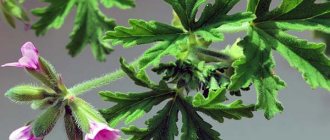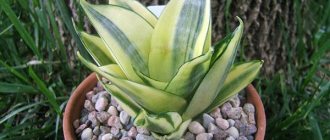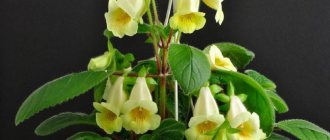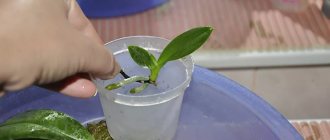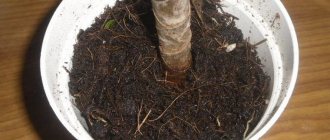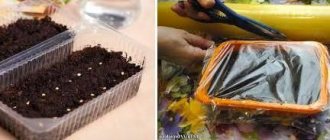- September 4, 2019
- Houseplants
- Blackwhisker Rose
Blooming geraniums adorn the windowsills of many city apartments and country houses. Also in summer it is used to decorate flower beds in garden plots. This flower is not at all capricious, which allows it to be grown very quickly in large quantities. Geranium gained enormous popularity several decades ago. Its second name is pelargonium. Recently, ampelous geranium, which climbs, has become popular. Interest in this plant increases every year, and more and more new varieties appear. Many readers are interested in learning about propagating geraniums by cuttings at home in the fall or at other times of the year. We invite you to learn about the most effective methods of breeding pelargonium.
Introduction to geranium
Pelargonium belongs to the Geranium family. She fell in love with the comforts of home. The plant pleases the eye with the abundance of shades of its inflorescences. Probably everyone recognizes geranium by the shape of its heart-shaped leaves. Europeans had the opportunity to admire pelargonium back in the 17th century. The plant was brought from Africa. Local breeders fell in love with geranium and developed many interesting varieties. Over the years, this beautiful and hardy indoor plant has found a place in various parts of the world.
The perennial is distinguished by an erect stem, long petioles, and branched roots. It also has long peduncles, and the flowers are collected in racemes. Each flower has 5 petals. Their shades are very different: from white to pink, lilac, red.
Today, both professionals and amateurs resort to propagating geraniums by cuttings at home. Pelargonium has some advantages:
- It is considered not only an indoor plant, but also a garden plant.
- Even the most experienced florist will satisfy his request among the many varieties.
- It does not require much time or serious effort to maintain, care and propagate this flower.
That’s why it won’t hurt you to learn how to propagate geraniums at home using cuttings or leaves.
How to take cuttings correctly
14–20 days before cuttings, you must stop watering the flower. To avoid dehydration and death of pelargonium, you can feed the plant with a solution of wood ash, which is prepared by mixing 1 liter of water with 20 grams of ash. During the preparation period, geraniums are moved to a shaded room. In this way, you can stimulate the formation of new shoots and significantly speed up the process of formation of new root shoots.
Geranium cuttings are cut from the mother plant using a sharp tool (knife, pruning shears). The cut area is sprinkled with crushed coal. During the selection process, it is necessary to select shoots that have a healthy appearance, as well as 3 well-developed internodes. After making the cut, it is necessary to remove the lower leaves of the inflorescences and dry the shoots, leaving them in a dark room until a thin film forms at the cut site (usually this takes about 2-3 hours). But when removing leaf blades, do not overdo it. After all, leaves are the only source of nutrition for pelargonium shoots, and the intensity of growth of new root shoots depends on them. Therefore, only the lower plates should be cut.
Since pelargonium is half a succulent, which is characterized by rapid decay after the integrity of their shell is damaged, drying is a mandatory step.
Important! The shoots are cut at an angle of 90° relative to the stem. It is also necessary to ensure that the cut site is located 0.5 cm below the node.
Types and preferences of plants
Most often, the following 4 types of geraniums are planted in pots:
- Ampelous or curly. Place in hanging pots near windows or entrance doors of the house.
- Fragrant. It grows as a lush bush with small leaves and flowers and emits a pleasant aroma.
- Royal. Tall bush with large bright flowers. It can be simple or terry.
- Zonal. They reproduce most often. It is distinguished by differently colored circles on the leaves.
All of the listed types of pelargonium have their own preferences. Most of all, this perennial loves timely watering, proper selection of location and soil, and fresh air. Pelargonium growing in a pot in the warm season is best placed on a balcony, terrace or garden. In winter and autumn, you must not forget about ventilating the room. This will help the plant fight fungal diseases.
Next you will learn more about the ways in which you can grow geraniums yourself at home, except for dividing the bush.
Sowing seeds
The main disadvantage of obtaining geraniums from seeds is that in this case it is not always possible to preserve varietal characteristics, and the process takes a lot of time. The most famous zonal geranium is most easily propagated by them from November to April.
Why do geranium leaves turn yellow at home - causes and treatment
Seed preparation (step-by-step instructions):
- the shell is removed from the surface (geranium seeds have a very dense top layer, partial destruction of the integrity of the peel helps speed up their germination);
- each seed is lightly rubbed with fine sandpaper;
- planting material is treated with phytohormones “Epin” or “Zircon”;
- then it is soaked in a weak solution of manganese for 20 minutes (to do this, dilute a pinch with 1.5 liters of water);
- pour warm water for 2-3 hours.
For germination, it is better to buy a ready-made mixture with nutrients, or make the right clay substrate yourself from peat, sand, humus (1: 1: 2).
Additional Information! Before growing geranium from seeds, it is necessary to carry out a procedure for disinfecting the soil. The fungicides “Trichodermin”, “Baktofit”, “Fitotsid-M”, “Fitosporin-M”, and copper sulfate are suitable for this.
Growing geraniums from seeds
Sowing process:
- a flat container is filled with drainage and soil;
- you need to sow seeds at a distance of 5-7 cm from each other;
- on top of the grains are sprinkled with soil or sand in a layer of 3-4 cm;
- the surface of the earth is moistened with a spray bottle.
The container is covered with a membrane or glass and placed in a well-lit place with a temperature of +23 degrees. Geranium seeds will sprout after 14 days. Young seedlings need to be protected from direct sunlight, drafts and drops during watering. After 30 days, when 2-3 leaves appear on the seedlings, they can be transplanted.
What do geranium seeds look like?
Material for planting can be purchased at the store, or collected independently from a pollinated plant. Brown seeds are 6-7 mm long. There are small depressions on the sides of the grains, and they feel hard to the touch. When selecting specimens for propagation, it is necessary to remove soft, deformed and tarnished grains. Many flower growers order material from China. For better germination, such seeds must be wrapped in a damp cloth and a plastic bag, and then placed in the refrigerator for 2-3 months for stratification.
When to plant so that geranium blooms in summer
Seed development occurs in any case: both in winter and in summer. Geranium from seeds - when to plant so that it blooms in pots and flower beds in summer? It is optimal to start sowing in March, when there is already enough sunlight. Then you will probably get blooming bushes this year. For successful summer flowering, the shoot will have enough time to take root and gain strength. A delay of just a month will move the flowering period of the bushes to next year.
Best time
What do you need to know about the time of propagation of geraniums by cuttings at home? It is better to do this from the end of February to the end of March - it is during this period that plant growth is activated. An autumn cutting option is also possible: late August or September. The main thing is to do this before the flower’s winter hibernation. Although, if you really want to, you can cut the petioles from pelargonium at any time.
The fastest rooting will be in spring chibouks, because the release of plant sap is accelerated. In winter, this process is slow, because the culture goes into a state of sleep. Summer rooting will also not be very rapid.
When is the best time to propagate geraniums?
The choice of time directly depends on the choice of reproduction method. When cutting and dividing a bush, it is recommended to choose March or November. In March, the plant emerges from hibernation and begins active growing season. This will greatly contribute to the speedy removal of roots and the further development of the plant. Cuttings planted in March will turn into lush flowering plants in the summer. If the end of autumn was chosen for propagation, the geranium may bloom in the spring, but seedlings planted in winter may not all take root.
If you choose the method of propagation by seeds, then January is most suitable. While the seed swells, it takes root and the first sprout is expelled, the spring time of active vegetation is just beginning.
How to propagate geranium at home using cuttings (step-by-step preparation)?
Here is an approximate procedure for selecting pelargonium planting material:
- Carefully inspect the mother plant and select the most suitable stem tips for cutting.
- Take a sharp knife or blade and carefully cut the stem from the donor plant. You can cut stems up to 10 cm long. Make the cut between two adjacent leaves.
- Do not send the cuttings straight into the pot, let them dry. Do this at normal room temperature.
- After the cuts on the plant have dried and a thin film has formed, treat these areas with ash or an absorbent.
- Tear off the lower leaves of the petioles, leaving 2-3 leaves is enough. Do the same with the buds on the tops, if any.
Advice from experienced flower growers
Sergey
“This information will be useful to lovers of beautiful indoor plants. I can say that geranium is the most pleasant and grateful plant. Plant the cutting in the pot, but place the pot on the well-lit side.
When watering, try not to wet the leaves with water. It is important to remember that any other indoor plant that has pubescent leaves should not be sprayed. The reason is that the leaves will gradually begin to rot, and the plant will begin to become very sick. Geranium, it takes root quickly, and what is important, it will delight with abundant flowering only if the pot is not too large.
In a large pot, the root system begins to develop more intensively, and accordingly, the plant leaves the forces that are aimed at flowering. That’s the whole secret of growing geraniums.”
Svetlana
“If possible, geraniums can be planted in open soil in the summer. It will actually grow much faster in the ground than in a pot. And in the fall, when digging, you can already divide the bush. I trim my pelargoniums at the end of February, and I leave a central shoot of 10-15 cm. This way they wake up and bloom faster.”
After propagating geraniums, you should still continue to properly care for the plant. Experienced flower growers advise following these rules:
- When replanting a plant, do not use old soil.
- Remove affected bushes regularly.
- Water the plant only after the soil has dried out.
- Follow the feeding regime. Try not to do this too often, as overdosing with fertilizer can harm the geranium.
- The bushes should be placed under lighting suitable for geraniums.
- Use quality and good drainage.
Natalia
“I recommend covering sprouts that begin to wilt after planting with a glass jar or any other material. Then an ideal microclimate will be created at the growing site for the rapid growth of geraniums. Important! Do not allow the leaves to come into contact with the glass; ventilate from time to time to prevent the so-called condensation from forming.”
Tatiana
“I managed to get the roots to develop faster. Therefore, I recommend cutting the stem around the stem two weeks before you separate the branches from the main plant. In this case, the incision site will become significantly denser, and some proliferating tissue will form with root rudiments in the form of small tubercles.”
Geranium is considered an ornamental crop, which is very popular among flower growers, as well as among ordinary people who simply enjoy the flowering of such a beautiful plant. From this article you learned how to propagate geraniums correctly, as well as which method is the best.
I would like to remind you that each method of reproduction has its own characteristics; they must be taken into account when choosing the option that is suitable for you. Nothing ends with reproduction. And then proper care should be carried out, which should be complete.
Pay special attention to the flower, then it will delight you with its long flowering and bright colors that will not leave anyone indifferent.
Proper rooting in water
Most often, chibuki are left to take root in water. If you also want to master the method of propagating geraniums by cuttings at home, then the following instructions will not hurt you:
- Keep the prepared planting material in a growth stimulator for up to half an hour.
- Prepare a plastic jar or glass for water. Pour settled water into it and add one crushed tablet of activated carbon. This will prevent the roots from rotting and the development of microbes.
- Dip the petioles halfway into the prepared water.
- Place the cups in a bright place, out of direct sunlight.
- If necessary, add water at room temperature over time; there is no need to change it.
- As soon as the roots appear, plant the petioles in the substrate.
What problems may arise during the operation?
Royal pelargonium is a delicate flower; the following problems may arise during its propagation:
- The cuttings do not take root - the specificity of the geranium variety . There are types of geraniums that do not produce roots. In this case, try to root the cutting in the soil. Some pelargoniums take one to two months to take root.
- The cutting was cut incorrectly . It must have at least two leaf nodes, or a heel and a leaf node with a bud.
- The stem has rotted . It is necessary to change the water and add activated carbon to it.
- The place where roots grow is located above the water . You need to monitor the water level; you can leave one bud above it.
- Insufficient soil moisture . The plant should be irrigated on time.
- The cutting is planted incorrectly . It must be deepened, leaving a growth point on the surface. After this, the possibility of roots appearing will increase.
- Geranium seeds are too deep . You should sow the seeds again, deepen them into the soil to a maximum of 3-4 mm.
- Poor quality seeds . Buy and sow seeds from a different manufacturer or from a different batch.
- Incorrect care . The seedlings should not be kept under a lid or film, the soil should be moist and loose, and should not be flooded.
- The soil is infected with blackleg . Before sowing, the soil should be disinfected, the seedlings should be regularly ventilated, and the soil should be sprinkled with ash. When infection occurs, diseased plants are removed, the soil is watered with a solution of potassium permanganate, and sprinkled with crushed charcoal.
- Lack of light . Seeds should be sown in March; early sowing requires illumination. Keep the plants on a bright window, turn the other side to the window glass every day.
It is recommended to plant new geraniums in disinfected soil and follow the watering order.
Rooting in the ground
Experienced gardeners plant petioles directly into the ground. You can try it too. First, place a layer of pebbles in plastic cups for drainage. Then pour the substrate on top. Deepen the cuttings 4-5 cm into it. Compact the soil and water generously. To help young plants adapt faster, place the glasses in the shade for several days. Before planting, do not forget to sprinkle each cutting tree with a root growth activator.
After 3-4 days, move the glasses to a bright place. The best temperature for rooting will be from +16 to +18 °C. It is better to water through a tray so that moisture does not fall on the leaves and stem - this way you will avoid the appearance of a black leg. After 3-4 weeks, root formation will begin.
If the cutting develops well, do not cover it with a jar or film. Otherwise, be sure to do it. In transparent glasses, the emerging roots will be clearly visible.
Reproduction methods
It is impossible to propagate geraniums by leaf or by dividing a bush, contrary to the assertions of some bloggers and authors of online articles. But the cuttings take root easily.
It makes sense to use the seed propagation method only if there is no other way to get the variety you like, or you need a lot of planting material at once, for example:
- for sale;
- for landscaping a large plot or office building.
Cuttings in water and soil
This method is used to propagate geranium at home more easily and most often. It is enough to have a twig, even a slightly wilted one, of Zonal or Ivy-leaved pelargonium to almost guarantee that you will quickly get a new flowering plant. Fragrant geranium takes root a little more difficult. With the propagation of Royal Pelargonium, Unicums and Angels, it is important to do everything correctly, otherwise there may be problems.
Harvesting cuttings
Geranium can be propagated using any pieces of stem. But the roots do not produce cuttings well:
- semi-lignified;
- without leaves;
- taken from the middle part of the branches of Unicums, Angels, Fragrant or Royal geraniums.
Pelargonium can be propagated in the spring from the tips of shoots remaining after pruning. At other times, you will have to cut them specially, preferably inside a bush, or an “out-of-order” branch, so as not to spoil the appearance of the formed plant.
Step by step:
- Take the tip of a shoot 7-15 cm long.
- Make the bottom cut oblique to increase the area for moisture absorption until the roots grow.
- Remove leaves that may be in water or soil.
- Dry the cuttings for 2-3 hours in the shade.
- For species that are difficult to root, treat the lower part with a stimulant.
If planting material for propagation is taken after the buds have advanced, the peduncle must be broken off. Otherwise, the geranium will not give roots, or will grow them for more than a month, even in the spring.
Propagation of Zonal and Ivy-leaved pelargonium works well with mid-summer cuttings. The bushes will turn out less beautiful than those from the tops, but they will quickly develop and bloom.
There are only a few differences from the previous operation:
- it is important that the propagation cuttings up to 10 cm long contain at least 2 internodes;
- the top cut should be straight;
- the lower leaves are also removed, the crown leaves, if they are too large, are shortened by half.
The distance from the cuts to the nearest node should be at least 1 cm.
Rooting
The cuttings can be placed in water, planted in a barren substrate or light soil. For capricious varieties or varieties that are being propagated for the first time, you need to try all the options, even combined ones, and choose the method that gives the best result. For example, many gardeners use this propagation method:
- Place the cuttings in water for 3-4 days;
- then they are immediately planted in a light substrate.
In water
Pour the settled liquid into a glass container. The lower end of the cutting should be submerged about 2 cm, but not touch the bottom.
It is convenient for such propagation to cover the neck with thick paper with a hole in the center through which the shoot is threaded. When the time comes to transplant the cuttings into the substrate, the leaf is simply cut.
The flower should stand in water until the roots grow to a maximum of 2 cm, or at least their rudiments appear - white dots on the part of the stem immersed in water. Too long lower shoots are fragile and easily break during transplantation.
The advantage of the propagation method: you can control the development of roots, and, if necessary, update the cut. Disadvantage: after moving into the ground, the young plant needs time to adapt; some of the shoots are injured.
In the substrate
Most gardeners prefer to immediately plant geranium cuttings during propagation in individual cups filled with light soil or infertile substrate:
- perlite;
- sand;
- their mixture with neutral peat.
It is up to the gardener to decide which propagation option to choose:
| Substrate | Advantages | Flaws |
| barren | roots grow quickly | transplantation is needed immediately after the appearance of the lower processes |
| low nutritional (light) | pelargonium can wait a month or more for transplantation | rooting is slow |
The geranium cuttings are planted so that the lower node is completely immersed in the substrate. Water abundantly, ensuring better adhesion of the stem to the soil.
Roots form faster if the shoot is inclined at an angle of about 45°.
Care
For successful propagation, geranium cuttings need the following conditions:
- temperature within 20-24° C;
- good lighting without direct rays;
- high air humidity.
When propagating geraniums in a substrate, it is impossible to spray the pubescent leaves - they rot easily. For the same reason it is not recommended:
- cover the cuttings with cellophane or glass;
- use a mini-greenhouse.
To increase humidity, bowls with water, wet sphagnum or pebbles are placed next to the seedling containers.
Watering is provided evenly and moderately. During propagation, the substrate should not dry out or become soaked, even for a short time. Fertilizing is done only if transplanting to a permanent place (in the ground or flowerpot) is postponed for a long time, with a half dose of specialized fertilizers.
Planting in a permanent pot
The sooner after rooting you plant geraniums from cuttings into containers filled with nutrient soil, the faster it will bloom.
Step by step:
- Take small pots or plastic cups with holes made in the bottom.
- One third is filled with drainage.
- Add a little nutrient substrate.
- A rooted cutting is installed in the center. It is better to keep it suspended so that the roots do not bend and the root collar is slightly below the edge of the container.
- Carefully add soil. Gently knead with your fingers, paying special attention to the area around the stem and near the sides.
- Water until water comes out through the drainage holes. You can add a root formation stimulator such as heteroauxin to it.
- For several days they are placed in a bright place, but protected from direct rays.
If geranium cuttings are rooted in a light substrate, do not replant, but transfer them to a large container.
Handle “with a heel”
Angels and Fragrant Pelargonium branch strongly. You can facilitate the propagation of geraniums as follows:
- Cut off the second-order shoot (branching from the main stem).
- Disassemble into short branches. They should not be pinched off, but carefully torn off entirely with your hands so that a piece of the bark of the older shoot remains at the base.
You can’t make a cut at the bottom; you can only slightly shorten the “tail” that turns out to be too long. Such cuttings are called “with a heel”; they are not placed in water; they are immediately planted in a light substrate. They take root very well.
Caudex geraniums, rare in Russia and neighboring countries, for example, Gvrnosum, can be propagated by shoots hatching from renewal buds. They are carefully cut off, capturing a tiny section of the caudex.
Planted like a cutting with a heel. The wound on the mother plant is sprinkled with crushed activated carbon. It will quickly tighten, the decorative effect will not be affected.
Seeds
This method is rarely used by amateurs, usually for mass reproduction, as an experiment, or to start a new cultivar. You can collect your own seeds only from varieties. Beautiful hybrids produce splitting and do not inherit the characteristics of the mother plant; planting material for propagation will have to be purchased.
Step by step:
- A wide, low container is filled with a damp mixture of peat and sand.
- Lightly compact.
- Level the surface.
- Seeds are scattered or rarely sown.
- Sprinkle with a layer of substrate about 5 mm.
- Spray with warm water from a household spray bottle.
- Cover with cellophane or glass, or place the container in a mini-greenhouse until shoots appear.
- Keeping at 22-24°C, ventilate daily, collect condensation, check soil moisture.
As soon as the first shoots appear:
- The cover is removed.
- For a week, transfer the propagation container to a room with a temperature of about 15° C.
- Provide round-the-clock illumination.
This will harden the geranium seedlings and prevent stretching of the hypocotyledon. After 7 days, the pelargonium is transferred to a room with a temperature of 18-20 ° C, and good lighting is provided for about 8-10 hours a day.
Home care for seedlings:
- The soil should be constantly moist, but not wet. Drying out is unacceptable even for a short time.
- It is necessary to ensure a constant flow of fresh air without drafts.
- At the stage of 2-3 true leaves, geraniums are planted in separate small cups with a light nutrient substrate.
- As they grow, they will need 1-2 transfers to large containers.
Propagation of geranium by leaf
Photos or videos showing the propagation of geraniums by leaves mislead flower growers. This vegetative organ does not have enough genetic material to develop into an independent plant.
Roots (not a new shoot) may appear, and not always, only if:
- remove the leaf without damaging the sheath of the petiole;
- Take together with the plate part of the integumentary tissue of the shoot on which it is attached.
If they show a leaf sticking out alone from the ground that has given rise to a pelargonium sprout, it means that propagation was carried out using a “hammer” cutting. The plate was cut together with a piece of stem containing 1 node, which was completely immersed in the ground.
Usually this method does not end in success. But it will give several new plants with a large amount of planting material.
Is propagation possible by dividing a geranium bush?
Pelargonium has a root, not a rhizome, and does not produce offspring. But in small-leaved varieties, for example, Angels, during reproduction, a number of short internodes appear below the surface of the soil. So they sometimes produce shoots located on the underground part of the main conductor.
If you dig up a plant, you may find that the branches have acquired their own roots. They are separated and seated.
Dilution in peat tablet
Fragrant and royal pelargonium require only rooting in the soil. Specialized stores sell special peat tablets in which cuttings develop very quickly. This rooting process is identical to the previous one - in the ground.
For work, prepare the same plastic glasses. Place a layer of drainage on the bottom. On top is a peat tablet. Water it lightly. Deepen the petiole ½ into the peat. There is no need to cover it with film. Place the glasses on a windowsill out of direct sunlight. Water moderately regularly. After 3-4 weeks the first roots will appear. The plant is ready for transplanting.
Choosing soil for pelargonium
After the roots of the future flower grow 3 cm, it needs to be replanted in the ground. Pelargonium will take root well in loose, well-drained soil. A ready-made universal substrate enriched with nutrients can be purchased at the store. Prepare it yourself by mixing in equal parts the components necessary for the growth and development of the plant:
- peat;
- turf land;
- medium grain sand;
- leaf humus;
- charcoal.
The soil should be neutral or slightly acidic, without signs of mold and insect larvae. To prevent plant diseases, the soil must be disinfected: spilled with a weak solution of potassium permanganate or heated with boiling water. You can combine these two types of antibacterial treatment for greater effect 2-3 days before planting. After disinfection, the soil should be shed with clean warm water.
Pelargonium leaves with roots
Planting rooted cuttings
Prepare pots for replanting. Remember that geraniums do not like large containers. Make drainage, fill the soil. Make a hole in the middle of the pot and insert the rooted planting material into it. Firm the soil around the stem.
What should the soil consist of? Peat and sand are required. The main quality of soil for geraniums is looseness. At any flower shop you can purchase special soil for pelargonium. After planting, water the plant and place it on the windowsill. If the first leaf appears, it means the plant has taken root.
Aftercare
Once geranium is planted in the ground, it, being an unpretentious plant, requires minimal care.
It consists:
- in watering (when planting you need plenty, and then moderate when the soil is already dry);
- in fertilizing (applying compost and peat during planting is usually sufficient);
- and pruning (for decorative purposes and for preventive purposes, to protect healthy parts of plants from rot).
Experience will help you root geraniums without losing planting material. There is no need to despair if the first result is not what you would like. After all, it depends on the type of geranium, and on the soil, and on the time of planting, and on other conditions. Only experiments will provide the necessary experience.
How to propagate geranium leaves at home?
The vegetative method of propagation is also acceptable for pelargonium. Geranium can be propagated by leaves. It is much more difficult to germinate them than cuttings, but it is still possible. This method is used if the plant suddenly gets sick and it is not possible to take the offspring. One nuance is important here: you need to pinch off the leaf so that a piece of the stem remains near it! It is processed in exactly the same way as regular cuttings. Such planting material takes root worse than petioles, and there is a risk of its death. You need to care for seedlings from leaves in the same way as planting cuttings.
Root propagation of pelargonium from sprouts
If pelargonium sprouts from the root, you can get new bushes from them. To do this, the bush is removed from the ground, shaken off, and the root system is divided so that the young leaf buds have roots for nutrition. It is important that the bores are small, otherwise the roots will intertwine and it will be impossible to separate them. The soil should be of normal composition, a small bowl with a diameter of no more than 10 cm.
That's all the wisdom of pelargonium propagation. As work progresses, each gardener develops his own techniques, which at times are far from the recommended ones.
Activities for caring for seedlings
Remember that geranium does not like the use of fresh organic fertilizers. It cannot be fed with manure and humus. Such actions will lead to the cessation of flowering. Indoor pelargonium requires the use of nutrient mixtures, which include all the essential minerals in equal doses. Active flowering requires potassium substances.
The stable growth of a newly propagated plant depends on trace elements: iron, zinc, copper, calcium, magnesium, manganese, boron. In summer, heat is stressful for a flower, so refrain from excessive fertilization. The optimal frequency of feeding should be 2 times a month. Note that geranium is not very demanding on air humidity. Any atmospheric conditions are suitable for its establishment, development and flowering. But the abundance of light is simply necessary for pelargonium.
How to care for the plant before and after the procedure?
Royal geraniums require special care. To ensure that your efforts are not in vain, a number of necessary conditions must be observed during the breeding period and immediately after it:
- Temperature and humidity. Pelargonium requires normal room temperature, without sudden changes and drafts. Humidity is moderate, dry air negatively affects its condition.
- Lighting. Geranium is light-loving, but cuttings and seedlings should be kept in places where there is moderate lighting. In summer, pelargonium is not recommended to be planted in open ground - it does not tolerate such conditions.
- Watering. It is necessary to water a new flower for the first time no earlier than ten days after planting it.
Then watering is done no more often than once every four to five days. It should be plentiful. It is more convenient to water through a tray: the flower will not be flooded, and the roots will receive the required amount of liquid. Warm water is used for watering so that the roots do not rot. - Feeding. New geraniums are fed no earlier than a month after propagation with a special or regular universal fertilizer.
Compliance with the rules for choosing soil, containers and further care of the flower will allow you to grow beautiful royal pelargonium. The choice of option for propagating geraniums depends on the experience, skill and desire of the grower. If everything is done correctly, it will be possible to receive new young flowers for yourself or as a gift within the year of planting.
Don't make mistakes, remember the problems of geranium
For most gardeners, cutting pelargonium does not cause any difficulties. If it is done well, it will immediately be reflected in the appearance of the flower. Unfortunately, sometimes pelargonium is susceptible to certain diseases. It won't hurt you to know about the main problems of this perennial:
- Sometimes the lower leaves turn yellow. If there is a lack of moisture, only the edges dry out. Over-watering leads to complete drying of the leaf.
- There are cases of redness of the edges of the leaves. This is a signal that the plant is cold. In winter, move the flower pot further from the window.
- If the stem darkens at the base, then it is affected by black leg. It will not be possible to save such a plant. It will also not reproduce. What is the reason? Possibly in dense and overly moist soil.
- Lack of light leads to bare stems.
- Rarely, mold may appear on the leaves. This phenomenon is associated with a fungal disease caused by excessive moisture. In this case, you need to remove the affected parts and treat the rest of the plant with a fungicide.
From all of the above, we can conclude that there is nothing difficult in propagating and caring for geraniums. You just have to correctly calculate the time for cuttings and harvesting planting material. Be responsible when selecting soil for rooting and replanting. All our recommendations will help you grow your own flowering beauties that will become a real decoration of your home and garden.
Selecting the time for cuttings
Manipulations related to interference with the biological structure of a flower should be carried out taking into account its annual cycle. Otherwise, propagation by geranium cuttings may not bring the desired result: the flower may not take root, lose its specific characteristics, or become vulnerable to all kinds of parasites and diseases. To prevent this from happening, it is advisable to cut geraniums in the spring (March-April) or autumn (August-September) period.
Important! In aging pelargonium, the ability to form new roots weakens or completely disappears. The reason for this state of affairs is a slowdown in the plant’s metabolic process, as well as a decrease in water-holding capacity. To prevent this from happening, it is recommended to strictly adhere to the timing of flower renewal.
In some cases, when it is necessary to save a dying flower, emergency cuttings are allowed, regardless of the time of year.
Watering and lighting
When propagating pelargonium by cuttings, the following conditions must also be observed:
- seedlings are placed in a well-lit place (but not in the open sun);
- optimal ambient temperature – +23 °C;
- Moistening the soil is done when it dries a third of the pot from the top;
- For faster growth of the cuttings, the leaves can be sprayed with solutions of growth stimulants (Zircon, Epin and others).
It is not recommended to place the cutting near heating appliances or in drafts. If the leaves begin to dry out, you can build a greenhouse for the plant from the cut off top of a plastic bottle. To harden the cutting and ventilate it, the lid is periodically opened. In other cases, greenhouses for geranium seedlings are usually not used.
Planting in disposable cups
There are several ways to propagate geranium: in plastic bottles, pots, peat tablets. Planting in transparent disposable cups is simple, economical and allows you to observe the development of the root system. Pre-prepare the soil and cuttings as described above. Then proceed as follows:
- For 100-gram plastic cups, cut off the transition from the walls to the bottom with scissors in 2-3 places;
- expanded clay or other drainage (fine gravel, crushed stone) is poured onto the bottom;
- place the prepared soil in a cup and spray it with a spray bottle;
- Use a wooden stick to make a depression in the center;
- plant the cuttings and compact the soil around them a little, place the glass on the pallet.
If the ground has become waterlogged, then place paper napkins or towels in 3-4 layers under the drainage holes to absorb excess water.
When can a flower be propagated in this way?
Geraniums can be propagated by cuttings all year round, but flower growers are of the opinion that during the dormant period (mid-autumn - end of winter) it is better not to touch the plant, because at this time it is very vulnerable, and therefore the mother geranium may die. Therefore, the most optimal period is spring, when geraniums begin their growing season and are still full of previously accumulated strength.
Propagation of a plant such as geranium is a fairly simple process that anyone who takes it upon can do it. And proper and timely care for a rooted plant will help it delight the eye with its attractive and aesthetic appearance.
